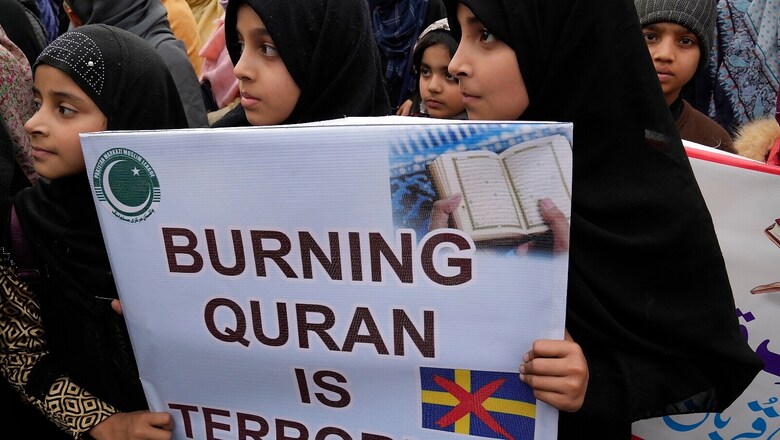
views
Pakistan’s foreign reserves have dwindled to a point where it can afford just two or three weeks’ imports. Power cuts are lengthening. Inflation is at half-a-century high, and food riots are breaking out.
But ignoring all that, thousands of faithful marched angrily in Lahore and Karachi last week to protest against the burning of the Quran 6,500 km away in Stockholm.
Strife-torn Iran and Iraq too set aside their priorities to protest the burning of the book near the Turkish embassy in Sweden by a far-right, anti-Islam politician, Rasmus Paludan. The dual Danish-Swedish national has promised to stage such protests every Friday in front of the Turkey embassy in Copenhagen. The permit for Paludan’s demonstration of 320 Swedish krona (USD 31) was paid by a Right-leaning journalist, Chang Frick.
If Paludan and Frick aimed for worldwide Islamic hysteria, they certainly achieved it. A seething Turkish President Recep Tayyip Erdogan threatened to block Sweden and Finland’s entry into NATO if the Scandinavian nations allow the desecration of the Quran. European standards of free speech, of course, starkly differ from Erdogan’s narrow, Islamist vision.
This is not the first time that the Islamic world has convulsed because of real and imagined slights to the Quran. Thousands have been lynched or executed for blasphemy in nations like Pakistan, flames have leapt up along the green arc from sub-Saharan Africa to Middle East to Pakistan to Bangladesh, Malaysia and Indonesia.
But is the Quran a document of god cast in stone? Questions abound.
Is it one book or just one version of many books?
Since the Quran was compiled long after Mohammed’s death by the third caliph, Uthman, who destroyed all other versions that existed then, could the words be taken as final?
Since the Quran was reconstructed from the memory of the Prophet’s companions, how real are the chances of omission, commission, and distortions?
Was the Quran originally spoken in Arabic or its cousin Aramaic, a semitic language which is over 3,000 years old?
What divine finality do Islamists fight for when it comes to the book when the book itself is wrapped in a thick mist of mystery, uncertainty, and intrigue?
Christoph Luxenberg’s (the author’s pseudonym) The Syriac-Aramaic Reading of the Quran suggests a new interpretation of the Quran assuming that some portions of the text were originally written in Aramaic, a language closely related to Arabic. Luxenberg argues that many disputed or obtuse Quranic verses can be better understood in Aramaic language and cultural context.
This view is supported by Al Fadi, former Wahabi Muslim from Saudi Arabia and founder of the Center for Islamic Research and Awareness (CIRA). It is widely accepted that an official and uniform Quran in a single dialect was created under Caliph Uthman (CE 644–656). The effort began 12 years after the Prophet’s death with Abu Bakr compiling accounts of Mohammed’s companions. It was apparently finished decades after his death.
Uthman sent a copy of his version of the Quran to each centre of the Islamic empire with the command that all other Quran materials be burned. So, ironically, the burning of Quran or Qurans began with the earliest, most pious and powerful of Muslims.
What Uthman may have wittingly or unwittingly done by sweeping aside the earliest writings is to discount versions of people who already knew the text by heart, taught by Mohammed himself.
One of the earliest Quranic texts, discovered in Yemen in 1972, are the Sana’a manuscripts. The lower text, which had been erased and Uthman’s Quran written on it, can still be red with ultraviolet light. Parts of it are significantly different from the standard Quran which is used today. But much of the collection remains unstudied and the rest not fully understood.
Then came the discovery and carbon-dating of the Birmingham Quran manuscripts in 2015, now kept as part of the University of Birmingham’s Mingana collection.
Gabriel Said Reynolds, professor of Islamic Studies and Theology, wrote a piece on the differences between extant Quran copies arguing that the lower script of the Sana’a palimpsest not only “does not agree with the standard text read around the world today”, but whose variants “do not match the variants reported in medieval literature for those codices kept by companions” of Mohammed.
He said, “One might imagine it is a vestige of an ancient version that somehow survived Uthman’s burning of all versions of the Quran except his own.” Reynolds asserts that the Sana’a manuscript is almost certainly the most ancient Quran manuscript.
Other scholars also testify that the earliest Qurans were not an immovable final word.
In his piece, ‘When did the consonantal skeleton of the Quran reach closure?’, Nicolai Sinai writes: “The Islamic tradition credits the promulgation of a uniform consonantal skeleton (rasm) of the Quran to the third caliph Uthman. However, in recent years various scholars have espoused a conjectural dating of the Quran’s codification to the time of Abd al-Malik, or have at least maintained that the Islamic scripture was open to significant revision up until 700 CE.”
Written after the Prophet’s death, the Quran is after all a reconstruction of memories. Some of the original narrative — words that exited Mohammed’s mouth — may have been overridden subsequently by a Caliph’s ego.
Instead of being violently thin-skinned about ‘the last book’ and ‘the final word’, sensible Muslims may invest some energy and curiosity in pursuit of the earlier, more authentic versions. The source code of their faith may have got altered with time.
Abhijit Majumder is a senior journalist. Views expressed are personal.
Read all the Latest Opinions here




















Comments
0 comment